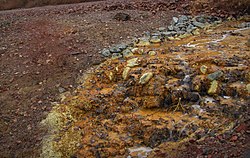Quicksilver Mine | |
 Pollution left behind | |
Location within the state of California | |
| Coordinates: 36°25′1″N 120°40′24″W / 36.41694°N 120.67333°W | |
| Country | United States |
| State | California |
| County | San Benito County |
| EPA code | CA0001900463 |
| Official name | New Idria Mine[1] |
| Reference no. | 324 |
The New Idria Mercury Mine encompasses 8,000 acres of land in the Diablo Mountain range, incorporating the town of Idria in San Benito County, California. Idria, initially named New Idria, is situated at 36°25′01″N 120°40′24″W / 36.41694°N 120.67333°W and 2440 feet (680m) above mean sea level. The area was, in the past, recorded in the US Census Bureau as a rural community; however, Idria has become a ghost town since the closing of once lucrative mining operations in the early 1970s.[2]
In 1990, the United States Environmental Protection Agency (EPA) investigated the mercury contamination level in soils, groundwater, surface water, and air of Idria, and concerned with the impact that the mining industry had had on the local environment. However, the contamination was not ranked high enough to be listed on the EPA's Superfund Site List, nor its National Priorities List.[3]
On March 10, 2011, after the site had been reassessed in 2002 along with an expanded site in 2009, the EPA finally proposed adding Idria to California's Superfund List. Mercury, along with heavy metals and acid mine drainage, were found in nearby San Carlos Creek, Silver Creek and a portion of Panoche Creek at high toxic level to aquatic organisms and nearby populations. The contamination was also shown to be potentially threatening to habitats extending to the San Joaquin River and San Francisco Bay.[4]
- ^ "New Idria Mine". Office of Historic Preservation, California State Parks. Retrieved 2012-10-11.
- ^ New Idria, California
- ^ "New Idria Quicksilver Mine". www.new-idria.org. Archived from the original on February 7, 2005.
{{cite web}}: CS1 maint: unfit URL (link) - ^ US EPA, OLEM (September 4, 2015). "Search for Superfund Sites Where You Live". US EPA.
